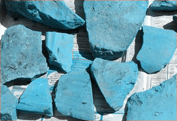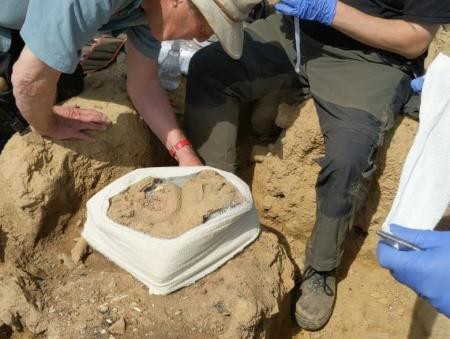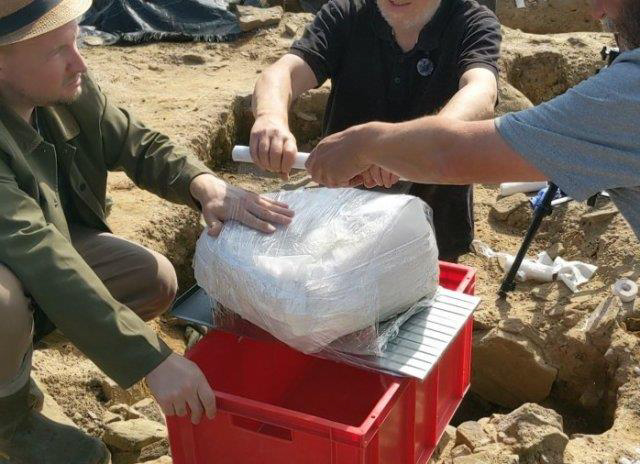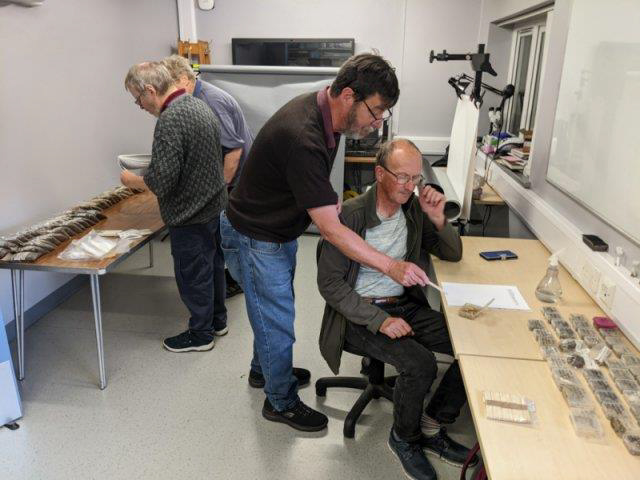

| No.280 July 2025 | Monthly Newsletter |
Aspull Ring Ditch Lifting of Urn2 |
|
Last month we completed the task of block-lifting our second urn and having it transported to the Museum's Archive facility in Bolton. For various reasons the exercise turned out to be more difficult than expected. The idea was that, once the block had been wrapped and encased in Plaster of Paris, we could crack it free from the underlying sandy clay. It could then be lifted on a steel supporting plate. All went well with the wrapping, first with cling film, then bandages, followed by a soft interface and then Plaster of Paris bandages. Once set, the block was gently undercut all around, ready for the next step which was to crack it away from the underlying clay. All this activity was supervised by Ben Dyson from GMAAS and Ian Trumble from Bolton Museum Services (Ian had already carried out the procedure on a different site). The next step though was the one that proved to be most difficult as it took some persuading with various tools before the block cracked free. However, this only occurred on the north side, leaving the south side stubbornly attached. The reason was that the sandy clay had not fully dried out on that side. Attempts to insert the steel plate were also hampered by small stones embedded in the block's underlying layer. Eventually though we were able to get two plates installed, one from either side, and the block was finally lifted. We wrapped it with more cling film before placing it in the box ready for its journey to Bolton. At the facility we will now be able to micro-excavate its contents in its climate-controlled environment. Since then, we've also transferred all the cremated bone already been removed from the burial pits. In the coming weeks we will be arranging regular visits to the facility, to carry out the cleaning and processing of the material. Meanwhile on site we have been progressing with our excavations. We have resumed the removal of the large cache of cremated bone from the pit under the two large slabs. We are also micro-excavating the contents of our first urn. This is on the advice from Ian Miller. who suggests this would ease the pressure on the wall of the vessel when we come to lift it. There is also an interesting development around the outer edges of the central monument. While searching for the extent of the mottled clay layer at the SE end of Trench 3a, we have come across a stony layer different in character to the general stony layer in the centre of the mound. These stones are smaller and embedded in a soft brown sandy clay. The mottled clay layer seems to be diving underneath this layer. A similar arrangement was found in 2023 in Trench 1c on the opposite side of the mound (and also possibly in Trench 10 on the west side of the mound). This suggests that the mottled clay layer of the mound was finished off with an edging of small stones As always you can find out more details on our dig diary here. Summer TripJust a reminder that this year we will be visiting the prehistoric sights on Anglezarke. Derek Cartwright will be once again leading the expedition which will include sites not visited on his first trip (i.e. Round Loaf and Black Coppice chambered cairn). The date is Saturday 9th August (if the weather is too bad on that day, we will postpone it for the following Saturday (16th)). If you are interested, please let me know so we can arrange car sharing. Next MeetingWednesday 2nd July at the Real Crafty on Upper Dicconson Street starting at 7.30pm as usual. In May I was lucky enough to visit the Stoke Museum. where part of the Staffordshire Hoard is currently on display. I must admit I was taken aback by the quality of the workmanship and thought I should learn more about these incredible artefacts. I found a recent online webinar by Professor Chris Fern assistant post-excavation manager at Cotswold Archaeology who excavated the find site. It was absolutely fascinating and very informative so, as we have no speaker next month, this will be our presentation this month. Hope you can make it -BA. |



